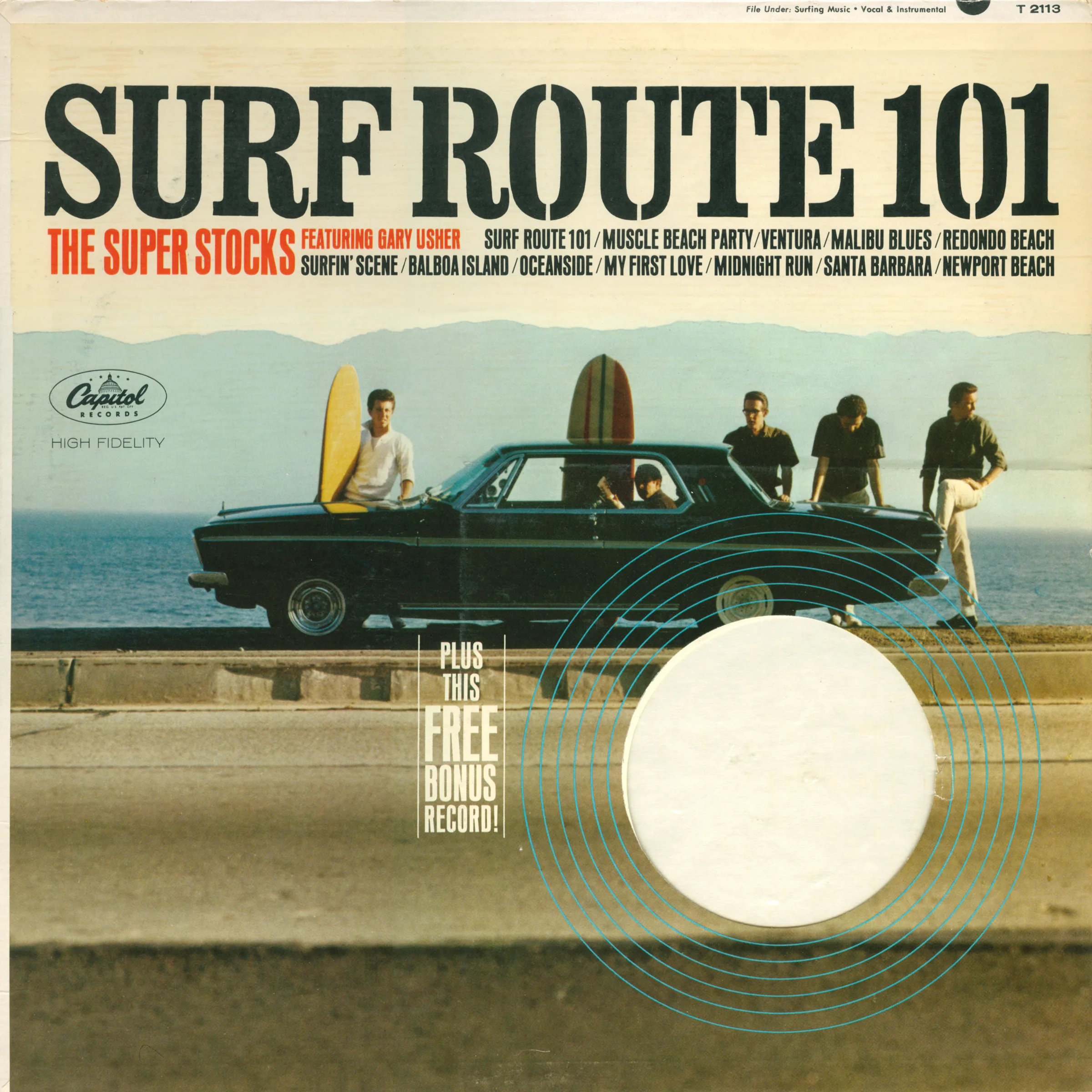
The Super Stocks
Surf Route 101

It is an eternal mystery how the most utterly disposable elements of pop culture wind up consistently becoming the subject of reappraisal. It’s also funny to think that at the time of their initial appearance they were items as common as could be: snapped up by the thousands or millions in a consumerist fad feeding frenzy, only to become highly valuable at a much later date. When American bubble gum companies first included baseball cards with packages of their product, they never could have conceived that one day kids would buy their product only to quickly discard the gum and retain the REAL GOLD, i.e.: the cards. And in the early sixties, pop music records were treated equally as ephemeral objects, not only by parents but their juvenile DJs as well, judging by the inordinate amount that turn up to this day in appalling states of condition — if it’s not the name of their owner written somewhere on the sleeve or label it was left to warp in the attic, mildew in the basement all the while retaining scratches that render it unplayable at any speed and unusable as anything but a brittle, skinny Frisbee.
The same REAL GOLD formula could be applied to the instrumental numbers on “Surf Route 101” which are a string of pearls in a sea of already tried and true, formula harmony pop from Gary Usher, then currently producing reams of Beach Boys-styled material at a ferocious rate that catered to the teenaged denizens of Southern California’s craze for recreational transport such as surfing, motorbikes, cars and more surfing. Preceding his work on “Pet Sounds” two short years later, an onslaught of records for Capitol and Mercury Records with a slew of session player-backed LPs from The Hondells, ridiculous cash-ins like “Mr. Gasser & The Weird-Ohs” and “Dracula’s Deuce” to The Super Stocks all bore his writing credits.
The Super Stocks released three albums within a period of two years and of this trio, “Surf Route 101” is by far their finest achievement. The five vocal tracks are harmony-led, harmless and as a result have not weathered the passing of time nearly as well as the instrumentals — all seven of which are absolutely fabulous. Most of them are entitled with the names of popular California surf spots and they’re all executed with a hot momentum by a crack team of sessioneers who knew their way around the studio and how to punch out completely tight arrangements. And among these session players were: Hal Blaine (drums), Carol Kaye (bass), Hondells guitarist Dick Burns and guitarist Richie Podolor, who on the cover is the gentleman seated in the place of honour inside the automobile. Rightly deserving the shaded comforts of the backseat as a momentary respite, because throughout the catchy infectiousness of the instrumental tracks his guitar playing is exquisite and sparkling, all iridescent riffs that reverb slightly and cascade within mighty tunes devoid of lyrics. And although the instrumentals all run for under two minutes, they speak volumes for days as their insane catchiness and terse completeness really work their way inside your head. “Ventura” holds a simple yet glistening guitar line that drives everything (even the bouncy piano line) ever onward: surrendering only briefly during the de rigueur “Wipe Out” drum bridge. “Santa Barbara” sees Blaine’s bucketful of drums corralled into the utmost discipline, giving his playing an unrestrained fire that burns brighter all the more for it. The next stop, “Redondo Beach” sees squonking frat sax enter for a bar or two over Blaine’s ratcheting up of the beat while keeping the rhythm rock steady into an ever-blowing scene, baby. “Balboa Island” is boppin’ sounds galore, while an organ passage two years before “Pet Sounds” enters on a key phrase. Less than 1:40 minutes in length, “Oceanside” is led by the sweetest, most gossamer guitar line rhythmically set against an amphetamine twist beat while maintaining lightness and uplifting the heart simultaneously. The guitar melody almost veers into utter dippiness but its many rippling qualities are handled so deftly it’s a dream and a half. After some interruption by further vocal tracks, the descending “Midnight Run” enters with shoreline darkness as Podolor’s expertly handled circular and high pitched playing weaves intoxication with brief whammy bar accenting. The mystery continues after “Malibu Blues” (a non-too convincing surfer’s delight cancelled by crummy weather) with “Newport Beach.” It’s equally as dramatic, but rendered even more so into gloomy darkness with Podolor’s reverbed riffs resounding into forgotten places that would soon resurface in his uncredited contributions on The Chocolate Watchband’s “No Way Out” and “The Inner Mystique” albums.
